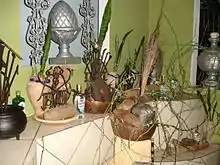Ogun
Ogun or Ogoun (Yoruba: Ògún, Portuguese: Ogum, Gu; also spelled Oggun or Ogou; known as Ogún or Ogum in Latin America) is a spirit that appears in several African religions. He attempted to seize the throne after the demise of Obatala, who reigned twice, before and after Oduduwa, but was ousted by Obamakin (Obalufon Ogbogbodirin) and sent on an exile – an event that serves as the core of the Olojo Festival. Ogun is a warrior and a powerful spirit of metal work,[1][2][3] as well as of rum and rum-making. He is also known as the "god of iron" and is present in Yoruba religion, Haitian Vodou, and West African Vodun.
| Ògún Ògún Lákáayé | |
|---|---|
Warriors, soldiers, blacksmiths, metal workers, craftsmen | |
| Member of Orisha | |
 Veve of Ogoun | |
| Other names | Oggun, Ogou, Ògún, Gou, Ogúm |
| Venerated in | Yoruba religion, Edo religion, Dahomey mythology, Vodun, Santería, Umbanda, Candomblé, Quimbanda, Haitian Vodou, Louisiana Voodoo, Folk Catholicism |
| Region | Nigeria, Benin, Latin America, Haiti, United States |
| Ethnic group | Yoruba people, Edo people, Fon people, Ewe people |
Yoruba religion

In Yoruba religion, Ogun is a primordial orisha in Yoruba Land. In some traditions, he is said to have cleared a path for the other orisha to enter Earth, using a metal axe and with the assistance of a dog. To commemorate this, one of his praise names, or oriki, is Osin Imole or the "first of the primordial Orisha to come to Earth". He is the god of war and metals.[2][1][3]
In his earthly life Ogun is said to be the first king of Ife. When some of his subjects failed to show respect, Ogun killed them and ultimately himself with his own sword. He disappeared into the earth at a place called Ire-Ekiti, with the promise to help those who call on his name. His followers believe him to have wo ile sun, to have disappeared into the earth's surface instead of dying. Throughout his earthly life, he is thought to have fought for the people of Ire, thus is known also as Onire.[1][2][3]
He is now celebrated in Ogun, Ekiti, Oyo, and Ondo States.
Followers
Ogun is the traditional deity of warriors, hunters, blacksmiths, technologists, and drivers in the Yoruba region. Followers of traditional Yoruba religion can swear to tell the truth in court by "kissing a piece of iron in the name of Ogun."[3] Drivers carry an amulet of Ogun to ward off traffic accidents.[1][2]
Symbols
The primary symbols of Ogun are iron, the dog, and the palm frond. They symbolize Ogun's role in transformation, mediation, and function. Iron is the primary emblem of Ogun. Ogun altars and ceremonies display and use iron objects both in Yoruba areas and across the African diaspora. Followers of Ogun wear chains of iron implements; Ogun festivals feature the display of knives, guns, blacksmith implements, scissors, wrenches, and other iron implements from daily life.
Sacrifice
Meats are sacrifices for Ogun. Dogs are the traditional companions of hunters, but Ogun's personality is also seen as "doglike": aggressive, able to face danger, and straightforward. Other sacrificial animals associated with Ogun are the spitting cobra (blacksnake); its behavior is aggressive and fearless. Hunters and blacksmiths avoid eating or witnessing the mating of blacksnakes. Other important sacrificial offerings to Ogun are the Clarias submarginatus (a species of catfish), alligator pepper, kola nuts, palm wine and red palm oil, small rats, roosters, salt, snails, tortoise, water, and yams. (Clyne: 1997). Many of these sacrificial offerings were carried into New World traditions.
Oríkì is a Yoruba cultural phenomenon that comes in the form of praise poetry, praising either a person, òrìṣà (deity), or town based on their achievements. Ogun worshippers are known to sing Ogun's oríkì and this specific part insinuates that Ògún is in seven paths.
- Ògún méje logun mi,
- Ògún alára ni n gb’aja,
- Ògún onire a gb’àgbò,
- Ògún Ikọla a gb'agbín,
- Ògún gbengbena oje ìgí nìí mu,
- Ògún ila a gb’esun iṣu,
- Ògún akirin a gb’awo agbo,
- Ògún elémono ẹran ahùn ni jẹ,
- mákindé ti dogun lẹyin odi,
- Bi o ba gba Tapa a gb’Aboki,
- A gba Ukuuku a gba Kèmbèrí.
Translation:
- My Ògún manifest in seven different ways
- Ogun of the town of Ilara accepts a dog atonement
- Ogun of the town of Ire accepts a ram atonement
- Ogun of the town of Ikole accepts a snail atonement
- Ogun of Gbenagena drinks tree sap for atonement
- Ogun of the town of Ila accept yam seeds atonement
- Ogun of the Akirin people accepts ram fur atonement
- Ogun of the Elemono people eats tortoise meat for atonement
- The brave that wages foreign wars
- He will consume either Nupe, or Hausa
- He consumes foreign people, He will consume the Kanuri too.
Dahomey religion
In Dahomey religion, Gu is the vodun of war and patron deity of smiths and craftsmen.[4] He was sent to earth to make it a nice place for people to live, and he has not yet finished this task.
Ewe religion
In Ewe religion, Gu also pronounced Egu is the god of war and craftsmen especially blacksmiths. Worshippers of Gu are not supposed to keep dogs as pets. Menstruating women are forbidden to touch the tools of the blacksmith. Adherents periodically make offerings of palm nuts, food and pour libations to Gu.
Candomblé

Ogun is known in the Afro-Brazilian tradition of Candomblé as Ogum (Ketu, Ijexa and Efon nations) or Gu (Jeje nation).[5] Ogum is syncretized with Saint George, notably in Rio de Janeiro and the state of Rio Grande do Sul. Candomblé tradition in Northeast Brazil, especially in Bahia, associates Ogum with Saint Sebastian or Saint Anthony.[6][4]
| Part of a series on |
| Yorùbá people |
|---|
 |
Characteristics
- Consecrated day: Wednesday
- Metal: iron
- Element: earth
- Color: red, black, green (Rio de Janeiro), blue (Bahia), marine blue
- Food: feijoada, xinxim, yams
- Archetype: impetuous, authoritarian, cautious, hardworking, suspicious and a bit selfish
- Symbols: sword, broadsword, iron chain[4][7]
Individual devotees of Ogun in Brazil avoid certain foods. These include goat, cajá-manga (Spondias dulcis), sugar, black beans, yams, and the manga-espada (an elongated mango cultivar of Brazil) in the Ketu nation; yams and manga-espada in the Ijexa nation; and partridge in the Jeje nation.[5]
Ritual sacrifice
Ogun, as a male orisha (Boró), only "eats" male animals. Ox, billy goat, rooster, snake (typically a red snake), dog and game animals are sacrificed ("orô") on festival days associated with Ogum in the Candomblé tradition.[8][9]
Ritual foods
Acaçá is a ritual food offered to all gods in the Candomble pantheon; it is made of a paste of corn mash steamed in banana leaves. A variation, acaçá de feijão-preto, substitutes black beans (Phaseolus vulgaris) for corn. This variation is only offered to Ogum in the Casa Fanti Ashanti temple in São Luís, in the state of Maranhão.[10] Feijoada, a stew of beans with beef and pork, is also a common offering to Ogum.[11]
Santería and Palo
Ogun's centrality to the Yoruba religion has resulted in his name being retained in Santería religion, as well as the Shango religion of Trinidad and Tobago. In Santería, Ogún is syncretized with Saint Peter, James the Great, Saint Paul, and John the Baptist; he is the deity of war and metals.[12]
Vodou
In Haitian Vodou Ogun is known as Ogou and consists of an array of manifestations; most carry the aspect of iron smithing and tools from the Yoruba tradition. The Ogou guard the badji, the sacred altar of the Vodou temple. He carries an iron saber and wears a red sash. Ogou is also the god of pioneering, intelligence, justice, medicine, and political power; these are associated with the symbol of the tool that can "advance humans' mastery over the environment.[13] Ogou Feray is the god of war. Other manifestations of Ogou are Ogou Badagri, Ogou Balenjo, Ogou Batala, and Ogou Je Wouj. Ezili Dantor is the female counterpart to Ogou.[13][14]
Ogou Feray is syncretized with St. James the Greater (St. Jacques Majeur) in the Vodou tradition. He is a flower spirit and he guides Vodou followers against their enemies. He is symbolically covered in iron and may not be harmed by his enemies. As in Africa, his symbol is a piece of iron, a machete, or a knife. As in Africa, Ogou is revered among blacksmiths, many of whom are of Yoruba origin. He is also noted to like women and alcohol.[13][14]
In Vodou ceremonies followers of Ogou wear a red shirt, pants, and scarf. A follower of Ogou in a possession-trance is offered Haitian white rum during the ceremony. In some ceremonies rum is burned in a container to allow Ogou to "wash" the hands of the followers.[14]
Two Vodou songs to Ogou, as recorded and translated by Michel S. Laguerre:[14]
Fè Ogou Fè, Ogou Fèray o,
Fè Ogou Fè, Ogou Fèray o
I am an iron,
I am covered with iron.
Fèrè Fèray tout ko Fèray sé kouto, Fèrè Fèray tout ko Fèray sé manchèt. The body of Ogou Fèray is covered with knives, The body of Fèray is covered with machetes.
In Brazil
Léo Neto, et al. observed various kinds of animals used in sacrificial ritual in twelve Candomblé communities of Caruaru, Pernambuco and Campina Grande, Paraíba in the Northeastern region of Brazil between August 2007 and June 2008; dogs were the only sacrificial animal offered to Ogun in both communities.[8]
References
- Adeoye, C. L. (1989). Ìgbàgbọ́ àti ẹ̀sìn Yorùba (in Yoruba). Ibadan: Evans Bros. Nigeria Publishers. pp. 250–262. ISBN 9781675098.
- Barnes, Sandra (1997). Africa's Ogun: Old World and New. Bloomington Ind: Indiana University Press. ISBN 0253-332516.
- Earhart, H (1993). Religious Traditions of the World: a Journey through Africa, Mesoamerica, North America, Judaism, Christianity, Islam, Hinduism, Buddhism, China, and Japan. San Francisco, California: HarperSanFrancisco. ISBN 9780060621155.
- Verger, Pierre (1999). Notas sobre o culto aos orixás e voduns na Bahia de Todos os Santos, no Brasil, e na antiga costa dos escravos, na África (in Portuguese). São Paulo: EDUSP. pp. 151–160. ISBN 9788531404757.
- Augras, Monique (2004). "Quizilas e preceitos--transgressão, reparação e organização dinâmica do mundo". Culto aos orixás: voduns e ancestrais nas religiões afro-brasileiras (in Portuguese). Rio de Janeiro: Pallas. pp. 190–193. ISBN 9788534702379.
- Assunção, Matthias (2005). Capoeira: the History of an Afro-Brazilian Martial Art. London New York: Routledge. p. 39. ISBN 0714650315.
- Hargreaves, Patricia, ed. (2018). Religiões Afro: as origens, as divindades, os rituais. São Paulo: Abril. p. 29. ISBN 9788569522492.
- Léo Neto, Nivaldo A.; Brooks, Sharon E.; Alves, Rômulo RN (2009). "From Eshu to Obatala: animals used in sacrificial rituals at Candomblé "terreiros" in Brazil". Journal of Ethnobiology and Ethnomedicine. 5 (1): 23. doi:10.1186/1746-4269-5-23. ISSN 1746-4269. PMC 2739163. PMID 19709402.
- Moura, Carlos Eugênio Marcondes de, ed. (2004). Culto aos orixás: voduns e ancestrais nas religiões afro-brasileiras (in Portuguese). Rio de Janeiro: Pallas. pp. 43–45. ISBN 9788534702379.
- Lody, Raul (2003). Dicionário de arte sacra & técnicas afro-brasileiras. Rio de Janeiro: Pallas. p. 36. ISBN 9788534701877.
- Fieldhouse, Paul (2017). Food, feasts, and faith : an encyclopedia of food culture in world religions. Santa Barbara, California: ABC-CLIO, an Imprint of ABC-CLIO, LLC. p. 93. ISBN 9781610694124.
- Falola, Toyin (2005). Yoruba Creativity: Fiction, Language, Life and Songs. Trenton, NJ: Africa World Press. ISBN 9781592213368.
- Galembo, Phyllis (2005). Vodou: Visions and Voices of Haiti. Berkeley, Calif: Ten Speed Press. pp. xxii–xxiii, 12. ISBN 9781580086769.
- Laguerre, Michel (1980). Voodoo Heritage. Beverly Hills, Calif: Sage Publications. pp. 131–137. ISBN 0803914032.
Bibliography
- Clyne, Robert Marcel (1997). Ogun Worship in Idanre: Iron and Identity in a Yoruba Town (Ph.D. thesis). Yale University.